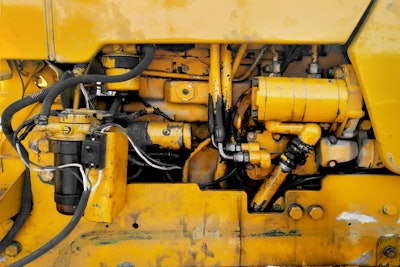
As service operations and processes become more complex, advanced technologies such as AI have become indispensable tools for many businesses in the construction industry. In 2023, the global AI market was valued at $515.31 billion but this is projected to grow to $621.19 billion in 2024 and reach a staggering $2,740.46 billion by 2032. So, what does this mean for the state of construction?
AI promises a new solution to two age-old problems: poor service delivery and customer experiences that fall short of expectations – but will we see this come true in 2024?
Eliminate Unwanted Production Downtime
One of the key metrics in field service has always been productivity (utilization): The amount of a contractor’s time actually spent on the job. This ‘wrench time’ typically ranges from anything between 50% and 95%, but most organizations are aiming for around 70 to 80% utilization.
Driving can easily occupy 30% of a contractor’s day, with administration adding a further 20-30%. But with the introduction of autonomous vehicles, travel is no longer downtime. With an autonomous vehicle managing the driving, contractors can prepare for their next visit, ensuring they are prepared.
Because autonomous journeys are digitally planned and routed, they are exceptionally efficient, and take into account EV range and charging needs. Human drivers need help to perform this well. AI-driven Planning & Scheduling Optimization (PSO) software can remove all the guesswork. As well as planning the optimum schedule and routes, the right application can use real-time vehicle telemetry data to dynamically make changes—for instance stopping to charge for 10 minutes, allowing a contractor to reach two more extra jobs, increasing daily productivity by 50%.
AI Can Automate Sales Opportunities
Streamed video data from assets, interpreted by computer vision, will increase the visibility of what contractor can see. For example, wind turbines are routinely equipped with IoT remote sensing. HVAC contractors have access to real-time performance and operational data from thousands of assets sold and maintained at hundreds of customer wind farm installations. Thanks to AI, intelligence from cameras, sensors, service records, and digital twin models can give contractors ultimate visibility.
AI can quickly identify any wind farm that is performing more efficiently and generating more energy than other comparable sites. Moreover, it can compare specifications to pinpoint why: for example, because a site uses a different, and more effective, gearing calibration. At this point AI has identified a competitive advantage, and a sales opportunity. It automatically generates a proposal to the operator of the under-performing wind farm site, offering a recalibration service that will deliver a guaranteed outcome of, say, a 20% uplift in power generation efficiency. This entire cycle, including service pricing, has been automatically initiated by AI with little or no human intervention, and no sales calls. Thus, moving from transaction-based sales to a consultative, fact-based, value-added partner.
Say Goodbye To Generic
Similarly, in a production environment, AI analysis can allow machine manufacturers to enhance efficiency, productivity, and throughput for customers throughout the lifecycle. This takes maintenance beyond preventing downtime to driving operational improvement.
By removing human subjectivity and anticipating changes, AI gives every company the potential to be a leader. Suddenly factors like the weather, sales trends, demand, usage duty and more are automatically part of an AI-enabled and informed performance picture. Even service no longer needs to be generic: AI can create instance specific documentation and recommendations, ensuring the right service part and optimal procedure and interval every time.
For example, The Rolls Royce Blue Data Thread program pulls engine performance data from multiple customer aircraft fleets. Using AI analysis, maintenance intervals for similar aircraft models are instance-specific—personalized based on engine use and wear. Alongside other operational suggestions, this value-added service already minimizes unnecessary Aircraft On Ground (AOG) time, increasing operational profitability.
Computer Vision In Preventative Maintenance
Where AI enables computers to think, computer vision enables computers to see, observe and understand. For example, AI can be trained to analyze and detect video imagery that would indicate a fault or safety hazard. Already, computer vision is being used in both the oil and gas and the maritime sectors to monitor and detect corrosion, informing timely manual inspections and preventative maintenance, whilst multi-camera equipped autonomous robots monitor operations in factories and warehouses.
Increasingly, passenger and commercial vehicles are now equipped with cameras, capturing video as they drive. By applying suitable image recognition algorithms, this stream data can be used for computer vision, reporting maintenance issues for infrastructure. Examples include road signs obscured by overgrowth, tree growth abrading overhead cables and phone lines, and vehicles automatically detecting and reporting locations for potholes.
Going Green Is Good
With increasing global scrutiny on sustainability, consumers and contracting businesses alike want to retain products and equipment for longer.
The circular economy has seen a shift in the sustainability model from stick to carrot: mandatory compliance to regulations has turned into active enthusiasm to become inherently sustainable. Contracting businesses know that consumers now want to engage with environmentally-conscious companies.
Equally, the outcome-based service model is also becoming more attractive. As consumers start to subscribe to offers such as heating-as-a-service, HVAC contractors can afford to optimally maintain assets to maximize their lifetime, reducing emissions, waste, and recycling.
I also expect we will start to see self-healing capabilities being designed into new products such as appliances and vehicles, eliminating the cost, time, and environmental impact of unnecessary field service visits.
Over the next year, AI will continue to integrate into more service offerings, assets, and operational workflows but this is just the start. AI has become a major industry-disruptor due to its advanced capabilities – and the construction industry is set to have a front-row seat on the new productivity and sales opportunities it can bring for digitally-minded businesses.


